How to Find Inverse Functions: Video Lesson
How to Find an Inverse Function
To find an inverse function:
- Replace the ‘f(x)=’ in the equation with ‘y=’.
- Replace every x in the equation with a y and the y with an x.
- Solve this equation for y.
- Replace the y with an f-1(x).
For example, find the inverse function for f(𝑥) = 5𝑥 – 2.
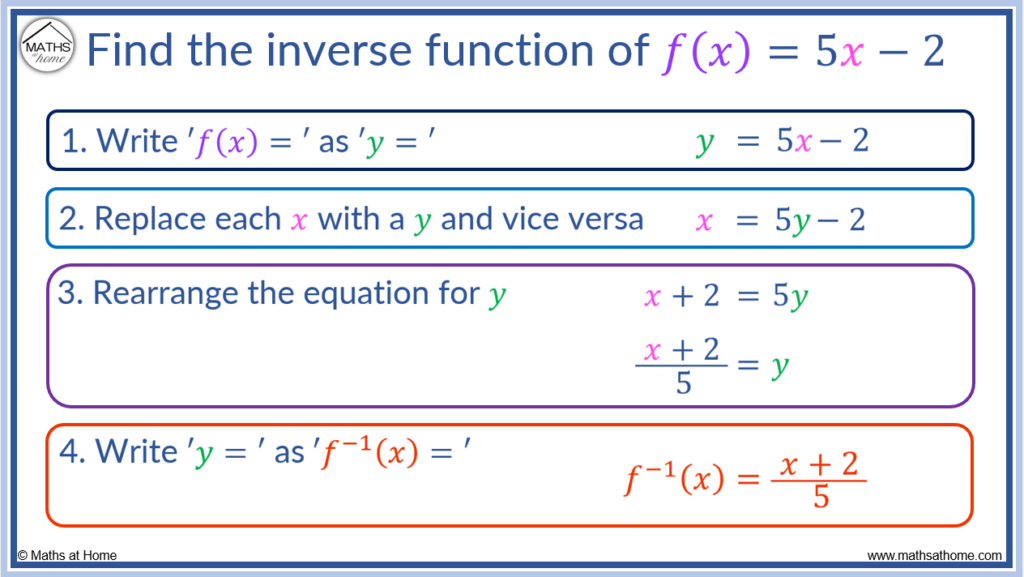
Step 1. Replace the ‘f(x)=’ in the equation with ‘y=’
We write f(𝑥) = 5𝑥 – 2 as y = 5𝑥 – 2.
Step 2. Replace every x in the equation with a y and the y with an x
We switch the 𝑥 for a y and the y for an 𝑥 so that the equation y = 5𝑥 – 2 becomes 𝑥 = 5y – 2.
Step 3. Solve this equation for y
We want to rearrange the equation to get ‘y=’.
We start with the equation 𝑥 = 5y – 2 and add to to both sides to get 𝑥 + 2 = 5y.
We now divide both sides by 5 to get .
Step 4. Replace the y with an f-1(x)
Instead of , we can write this as
to indicate that this is the inverse function of f(𝑥) = 5𝑥 – 2.
f-1(𝑥) is the correct way to write the inverse of f(𝑥). The correct way to say this is ‘f inverse of 𝑥’. f-1(𝑥) does not mean to raise the function f(𝑥) to the power of -1. This is just the notation used to indicate an inverse.
What are Inverse Functions?
An inverse function is a function which undoes the operation of the original function. For any one-to-one function, f(x), there is an inverse function, written as f-1(x). The graph of the inverse function is a reflection of the original function in the line y = x.
The function is not a one-to-one function and so, to find its inverse, we must restrict the domain to 𝑥≥0 so that the function is one-to-one. This portion of the graph is shown below, with no graph in the negative quadrants of the axes.
The inverse of this restricted function is now shown as .
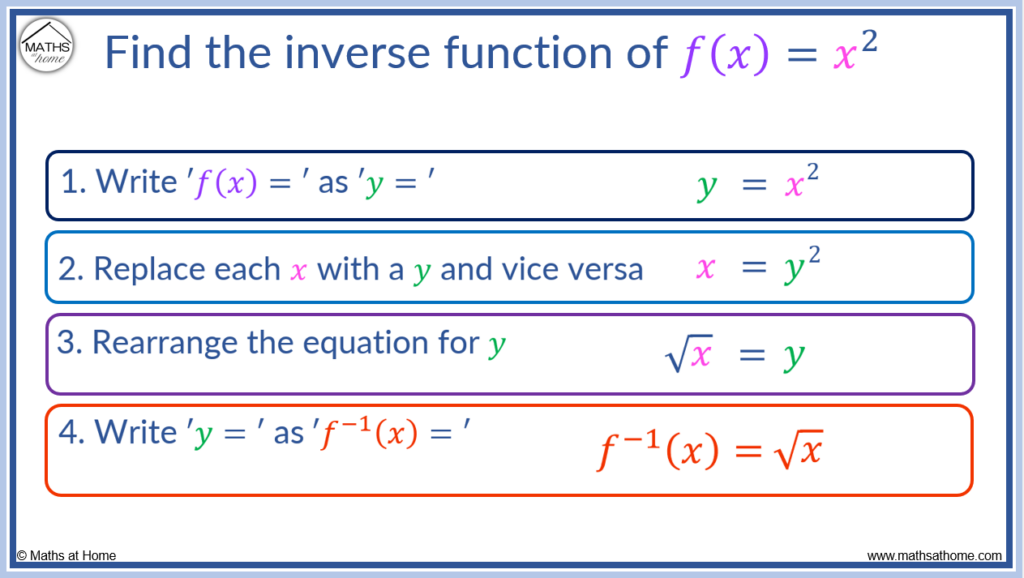
The inverse function is a reflection of the original function in the line y = 𝑥.

The domain of an inverse function is equal to the range of the original function.
The range of an inverse function is equal to the domain of the original function.
We can see on the graph above, that the domain of the inverse function is equal to the range of the original function. This rule occurs because a function and its inverse are a reflection of each other in the line y = 𝑥.
Properties of Inverse functions
Inverse functions have the following properties:
- A function only has an inverse if it is a one-to-one function. An inverse function must also be a one-to-one function.
- For a function f(x), its inverse is written as f-1(x).
- When the inverse of the function is the same as the function itself, the function is known as a self-inverse function.
- f-1(f(x))=x for all x in the domain of f(x).
- The inverse of an inverse function is the original function itself. f-1(f-1(x))=f(x).
- An inverse function is a reflection of the original function in the line y = x.
- An inverse function will only intersect the original function on the line y = x.
- For any point (a, b) on a function, there exists a point (b, a) on the inverse function.
- The domain of the inverse function is equal to the range of the original function.
- The range of the inverse function is equal to the domain of the original function.
Inverse Function Examples and Solutions
The following table lists some common functions and their inverses.
| Function f(𝑥) | Inverse Function f-1(𝑥) | Domain of the inverse |
| f(x) = x + k | f-1(x) = x – k | Any real number |
| f(x) = kx | f-1(x) = x/k | k≠0 |
| f(x) = 1/x | f-1(x) = 1/x | x≠0 |
| f(x) = x2 | f-1(x) = +√x | x≥0 |
| f(x) = x3 | f-1(x) = 3√x | Any real number |
| f(x) = xn | f-1(x) = x1/n | n ≠0. For even n, x≥0. |
| f(x) = ex | f-1(x) = ln(x) | x>0. |
| f(x) = kx | f-1(x) = logk(x) | k>0 and x>0 |
| f(x) = sin(x) | f-1(x) = sin-1(x) | -1 ≤ x ≤ 1 |
| f(x) = cos(x) | f-1(x) = cos-1(x) | -1 ≤ x ≤ 1 |
| f(x) = tan(x) | f-1(x) = tan-1(x) | Any real number |
The Inverse of a Linear Function
For any linear function of the form f(x) = mx+c, the inverse function is f-1(x) = (x-c)/m. For example, the inverse of the function f(x) = 3x + 5 is f-1(x) = (x-5)/3.
The steps for finding the inverse of a linear function are shown below.
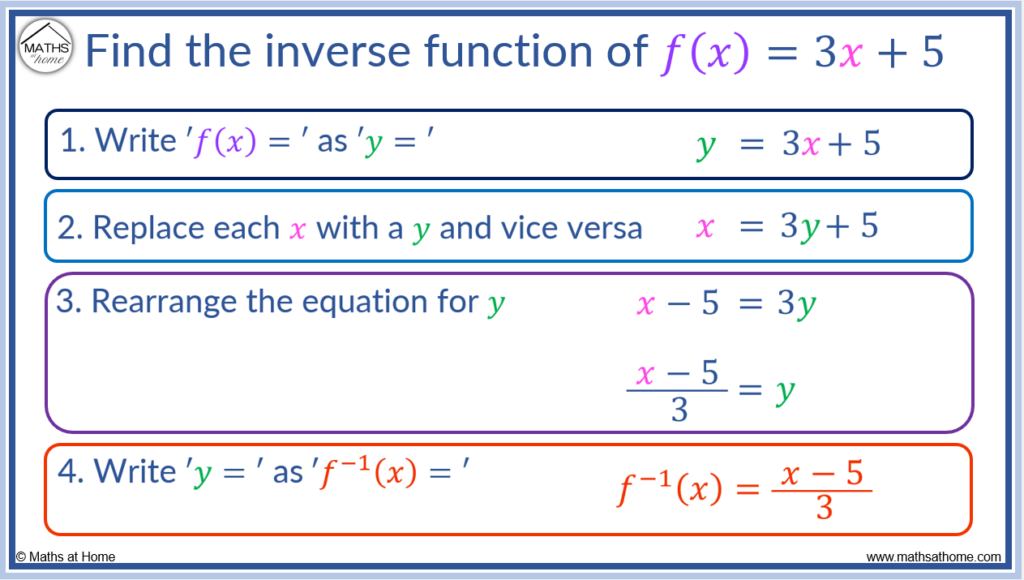
Step 1. Write the function as y =
We write f(𝑥) = 3x + 5 as y = 3𝑥 + 5.
Step 2. Replace each x with y and vice versa
y = 3𝑥 + 5 becomes 𝑥 = 3y + 5.
Step 3. Rearrange the equation for y
We subtract 5 from both sides of the equation so that 𝑥 = 3y + 5 becomes 𝑥 – 5 = 3y.
We divide both sides of the equation by 3 to get .
Step 4. Write the equation as f-1(x)
We write the inverse function as .
The Inverse of Functions with Square Roots
To find the inverse of a function written under a square root, replace each x with a y and the y with an x. Rearrange the equation for y by squaring both sides of the equation. This will remove the square root operation.
For example, find the inverse of the function .
Step 1. Write the function as y=
We write as
.
Step 2. Replace each x with a y and vice versa
becomes
.
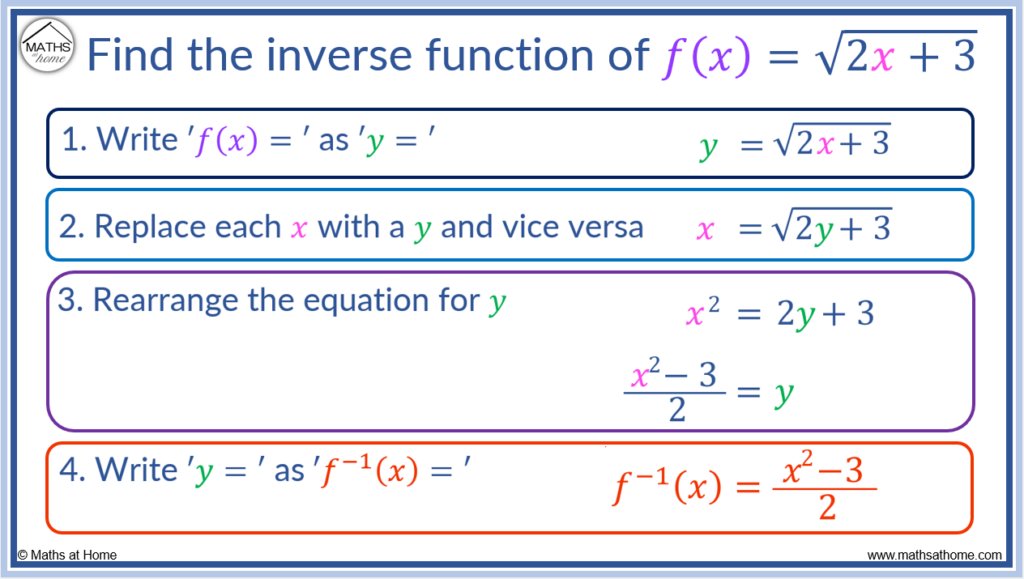
Step 3. Rearrange the equation for y
Square both sides of the equation so that becomes
.
Subtract 3 from both sides of the equation to get .
Finally divide both sides of the equation by 2 to get .
Step 4. Write the inverse function as f-1(x)
We write the inverse function as .
The Inverse of Functions Written as a Fraction
To find the inverse of a function written as a fraction, first replace each x with a y and each y with an x. Then rearrange the equation for y. To do this, multiply both sides of the equation by the denominator of the fraction. Then expand the brackets, collect the y terms together and factorise out y.
For example, find the inverse of the function .
Step 1. Write the equation as y =
We write the function as .
Step 2. Replace each x with a y and vice versa
The function becomes
.
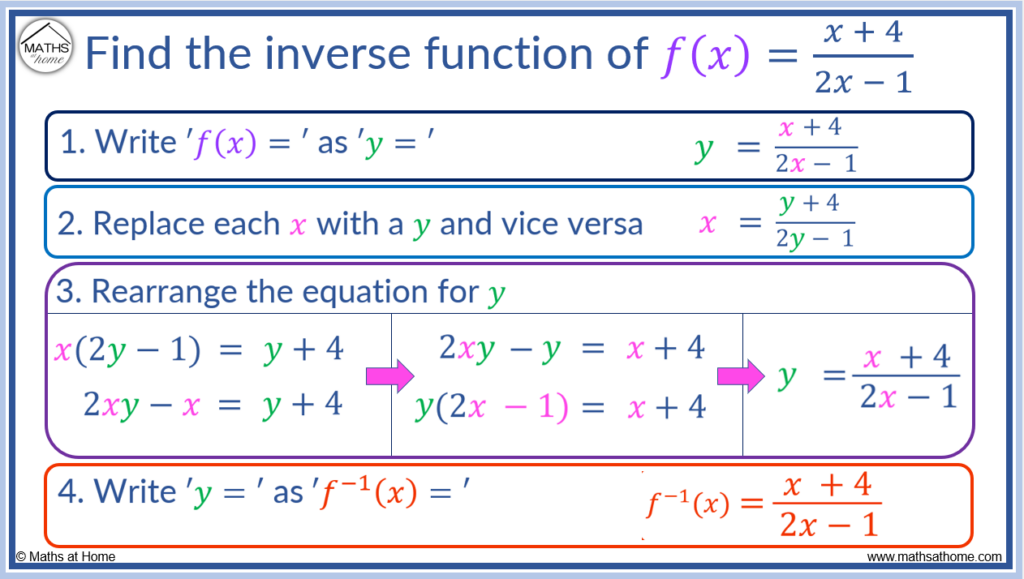
Step 3. Rearrange the equation for y
We first multiply both sides of the equation by the denominator of the fraction (2y-1).
becomes
.
We then expand the brackets on the left hand side of the equation to get .
We then gather the y terms together on the left hand side and move every other term to the right hand side.
Add 𝑥 to both sides and subtract y from both sides to get . We now have the y terms on the left hand side.
We now factorise the y out on the left hand side to get .
Finally, we divide both sides of the equation by the bracket on the left hand side of the equation to solve for y.
Step 4. Write the inverse function as f-1(x)
We write as
.
We can see that the inverse function is identical to the original function and so, this function is self inverse.
The Inverse of the Function 1/𝑥
The inverse function of f(x) = 1/x, is f-1(x)=1/x. That is, the inverse function of 1/x is 1/x itself. When the inverse function is the same as the original function, the function is known as self-inverse. Therefore f(x) = 1/x is a self-inverse function.
We will show the steps for calculating the inverse of below.
Start by writing the function as .
Swap the positions of 𝑥 and y to get .
Then multiply both sides of the equation by y to get .
We then divide both sides of the equation by 𝑥 to get .

The inverse function is the same as the original function and so, we call this function self-inverse.
The domain of the function f(𝑥) = 1/𝑥 is 𝑥 ∈ ℝ, 𝑥 ≠ 0. We cannot divide by 0 and so, this value is excluded from our domain.
The range of the function f(𝑥) = 1/𝑥 is 𝑥 ∈ ℝ, 𝑥 ≠ 0. There is no value of 𝑥 which can be input to obtain an output of 0.
The Inverse of a Cubic Function
Cubic functions that are not one-to-one functions do not have an inverse. However, cubic equations written in the form f(x)=(ax+b)3+c do have an inverse, which is f-1(x)=(∛(x-c)-b)/a.
For example, find the inverse of the cubic function f(𝑥) = 𝑥3 – 2.

We first replace the 𝑥 with a y and the y with an 𝑥.
y = 𝑥3 – 2 becomes 𝑥 = y3 – 2.
Then we rearrange the equation for y. We first add 2 to both sides of the equation to get 𝑥 + 2 = y3.
Now we cube root both sides of the equation to get ∛(𝑥 + 2) = y.
We write the inverse as .
The Inverse of a Logarithmic Function
The inverse of a logarithmic function of the form f(x)=logk(x) is f-1(x)=kx. The inverse function of any logarithmic function can be found by replacing the positions of x and y and solving the equation for y by rewriting the equation in index form.
For example, find the inverse function for .
Step 1. Write f(𝑥) as y =
Instead of , we write
.
Step 2. Replace each x with a y and vice versa
To find the inverse of this logarithmic function we switch the 𝑥 and y variables.
becomes
.

Step 3. Rearrange the equation for y
We solve the equation for y by writing it in index form.
becomes
.
We then subtract 2 on both sides of the equation to get .
Step 4. Write the inverse function as f-1(x)
We write as
.
The domain and range of the function f(𝑥) become the range and domain of f-1(𝑥) respectively.
The range of the function is any real number, f(𝑥) ∈ ℝ. Therefore the domain of the inverse function,
is any real number, 𝑥 ∈ ℝ.
The domain of the function is 𝑥>-2. This is because we cannot input zero or below into a logarithmic function. If 𝑥 is -2 or below, then the input to the log is zero or below.
Therefore the range of the inverse function, is f(𝑥) > -2.
